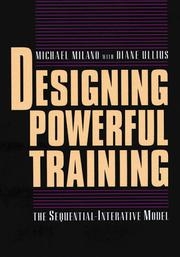Designing Powerful Training: The Sequential-Iterative Model (SIM)

Buy online ($)
Type
Book
Authors
Michael Milano ( . )
Diane Ullius ( . )
ISBN 10
0787909661
Category
Human Resources 12
[ Browse Items ]
Publication Year
1998
Publisher
Volume
1
Pages
352
Tags
Description
"An excellent, comprehensive, and very practical guide for training design.
--Beverly Popek, director of human resources, professional & consulting services, MCI Telecommunications
The answer is here. The heart of this book is the Sequential-Iterative Model (SIM) for training design. A fancy term for a simple, elegant concept: training should be a step-by-step process with a feedback loop that enables you to continually refine your training based on experience.
"You will not find another book that so thoroughly examines the process of creating training events. For anyone who wants to do quality design work, this book is highly recommAnded."
--Mel Silberman, author of Active Training and 101 Ways to Make Training Active
This book is a tool to help you design training that is:
Effective: Accomplishing specific objectives that aim toward success
Efficient: Meeting training objectives without wasting time or energy
Engaging: Involvin g learners and incorporating their experience into the training
You get checklists and evaluations to guide your development process. Out of their many years of experience, Milano and Ullius have created a practical guidebook that enables you to structure training so it is fluid and adaptable. Many guides to instructional design are stuffy, academic, and difficult to apply to the real world. Not so with Designing Powerful Training. This book is easy to approach and visually refreshing, with over 70 figures and illustrations!
You'll receive an overview of training basics, including:
Identifying the central characteristics of adult learners
Recognizing the essential skills for instructional design
Conducting a simple and quick needs assessment . . . and much more!
Next, the authors introduce you to the revolutionary SIM design. This design guides you through:
defining training goals and objectives
designing a big-picture outline for your training program
refining your outline to create a detailed training process
selecting media for your training events
evaluating the success of your designs.
"I like this book! The [SIM] gives me the connection between training design and organizational performance needs I have been looking for in other books."-- Joseph A. Greenberg, professor of higher education administration, The George Washington University
An essential piece of the puzzle is the running example that the authors follow throughout the book. This is where the rubber meets the road. You see the SIM in action and you recognize how you'll make it work for you.
--Beverly Popek, director of human resources, professional & consulting services, MCI Telecommunications
The answer is here. The heart of this book is the Sequential-Iterative Model (SIM) for training design. A fancy term for a simple, elegant concept: training should be a step-by-step process with a feedback loop that enables you to continually refine your training based on experience.
"You will not find another book that so thoroughly examines the process of creating training events. For anyone who wants to do quality design work, this book is highly recommAnded."
--Mel Silberman, author of Active Training and 101 Ways to Make Training Active
This book is a tool to help you design training that is:
Effective: Accomplishing specific objectives that aim toward success
Efficient: Meeting training objectives without wasting time or energy
Engaging: Involvin g learners and incorporating their experience into the training
You get checklists and evaluations to guide your development process. Out of their many years of experience, Milano and Ullius have created a practical guidebook that enables you to structure training so it is fluid and adaptable. Many guides to instructional design are stuffy, academic, and difficult to apply to the real world. Not so with Designing Powerful Training. This book is easy to approach and visually refreshing, with over 70 figures and illustrations!
You'll receive an overview of training basics, including:
Identifying the central characteristics of adult learners
Recognizing the essential skills for instructional design
Conducting a simple and quick needs assessment . . . and much more!
Next, the authors introduce you to the revolutionary SIM design. This design guides you through:
defining training goals and objectives
designing a big-picture outline for your training program
refining your outline to create a detailed training process
selecting media for your training events
evaluating the success of your designs.
"I like this book! The [SIM] gives me the connection between training design and organizational performance needs I have been looking for in other books."-- Joseph A. Greenberg, professor of higher education administration, The George Washington University
An essential piece of the puzzle is the running example that the authors follow throughout the book. This is where the rubber meets the road. You see the SIM in action and you recognize how you'll make it work for you.
Number of Copies
1
| Library | Accession No | Call No | Copy No | Edition | Location | Availability |
|---|---|---|---|---|---|---|
| Main | 158 | 1 | Yes |




